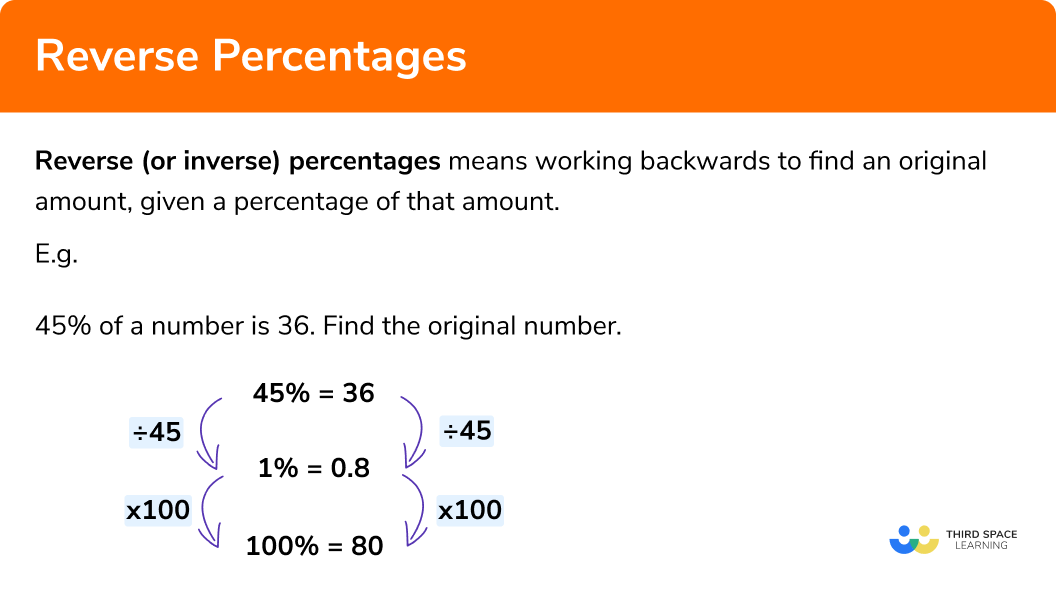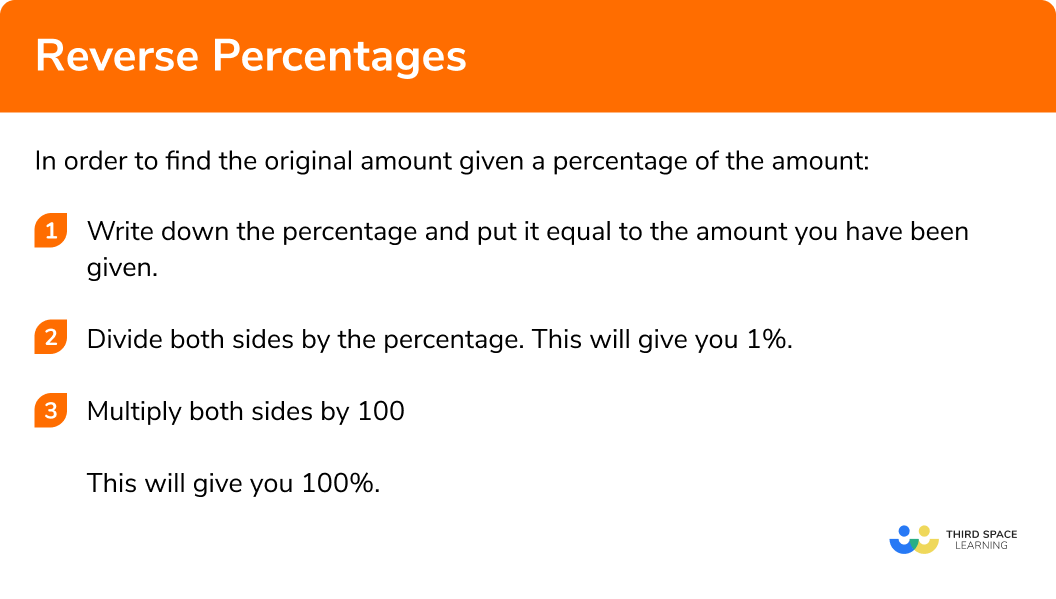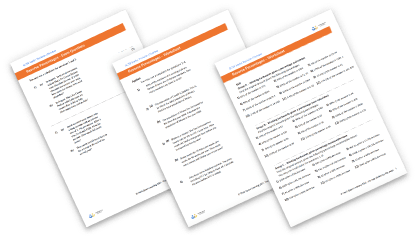GCSE Tutoring Programme
"Our chosen students improved 1.19 of a grade on average - 0.45 more than those who didn't have the tutoring."
In order to access this I need to be confident with:
Percentages Percentage increase Percentage decrease ProportionThis topic is relevant for:

Reverse Percentages
Here we will learn about reverse percentages (or inverse percentages) including how to work backwards to find an original amount given a percentage of that amount or a percentage increase/decrease.
There are also reverse percentages worksheets based on Edexcel, AQA and OCR exam questions, along with further guidance on where to go next if you’re still stuck.
What are reverse percentages?
Reverse percentages is a way of working backwards on a percentage problem to find an original amount.
In order to do this:
- We can use a calculator to take the percentage given, divide to find
1% and then multiply by100 to find100% . - We can also do this without a calculator by using factors of the percentage we have been given.
- Sometimes we are given a percentage of an amount and must work out the original value.
We need to remember that the original amount is
What are reverse percentages?

How to use reverse percentages given a percentage of an amount (calculator method)
In order to find the original amount given a percentage of the amount (using a calculator):
- Write down the percentage and put it equal to the amount you have been given.
- Divide both sides by the percentage.
(e.g. if you have80% , divide both by80 ). This will give you1% . - Multiply both sides by
100 .
This will give you100% .
Explain how to find the original amount given a percentage of the amount in 3 steps


Reverse percentages worksheet

Get your free reverse percentages worksheet of 20+ questions and answers. Includes reasoning and applied questions.
DOWNLOAD FREE
Reverse percentages worksheet

Get your free reverse percentages worksheet of 20+ questions and answers. Includes reasoning and applied questions.
DOWNLOAD FREEReverse percentage examples (calculator method)
Example 1: calculator
- Put the percentage equal to the amount.
2 Divide both sides by the percentage to find
In this case the percentage is 45%, so divide by 45.
3 Multiply by
The original number was
Example 2: calculator
Put the percentage equal to the amount.
Divide both sides by the percentage to find 1%. In this case the percentage is 150%, so divide by 150.
Multiply by 100 to find 100%.
The original number was
How to use reverse percentages given a percentage of an amount (non-calculator method)
In a situation where we do not have a calculator, we can often simplify the problem by using common factors. Rather than finding
Here to calculate a reverse percentage, you can use the following formula:
- Write down the percentage and put it equal to the amount you have been given.
- Identify a common factor of the percentage and
100% (a number which goes in to both). - Use division to find that percentage of your amount.
- Use multiplication to find
100% .
Reverse percentages examples (non-calculator method)
Example 3: non-calculator
Put the percentage equal to the amount.
Identify a common factor of 70% and 100%.
Factors of
Factors of
Here
As 10% is a factor of both 70% and 100%, we need to find 10% of our amount. To do this we will divide by 7 because 70% ÷ 7 = 10%.
As we now have 10%, we need to multiply by 10 to find 100%.
The original amount was
Note: In this example, and every example, the method of finding
Example 4: non-calculator
Put the percentage equal to the amount.
Identify a common factor of 125% and 100%.
Factors of
Factors of
Here we are going to use
As 25 is a factor of both 125% and 100%, we need to find 25% of our amount. To do this we divide by 5 because 125% ÷ 5 = 25%.
As we now have 25%, we need to multiply by 4 to find 100%.
The original amount was
How to use reverse percentages given a percentage increase/decrease
Sometimes, instead of being told a percentage of the amount, we are told what percentage increase or decrease has occurred.
The only difference here compared to what we have already looked at is that we first need to identify what percentage of the original amount we now have.
- Identify what percentage of the original amount you now have.
If it has been increased by a percentage, add that percentage onto100% .
If it has been decreased by a percentage, subtract that percentage from100% . - Write down the percentage and put it equal to the amount you have been given.
- Use either the calculator or non-calculator method to find
100% .
Reverse percentages examples (percentage increase/decrease)
Example 5: percentage increase, calculator
The number of fans attending a football match this week was 12% more than last week. If 728 people attended the match this week, how many attended last week?
This is a percentage increase of 12%.
Write down the percentage and put it equal to the amount you have been given.
This is a calculator question, so use the method of finding 1%.
The number of fans last week was 650.
Example 6: percentage decrease, calculator
The value of a car has decreased by
This is a percentage decrease of 16.5%.
Write down the percentage and put it equal to the amount you have been given.
Use a calculator to find 1%.
The original price was
Example 7: percentage increase, non-calculator
A puppy’s weight has increased by
This is a percentage increase of 20%.
Write down the percentage and put it equal to the amount you have been given.
This is a non-calculator question, so use the common factor method.
Factors of
Factors of
There are several common factors here. It would be easiest to use
The puppy’s original weight was
Example 8: percentage decrease, non-calculator
A television is in a
This is a percentage decrease of 10%.
Write down the percentage and put it equal to the amount you have been given.
This is a non-calculator question, so use the common factor method.
Factors of
Factors of
Here we are going to use
The original price of the television was
Common misconceptions
- Calculating a percentage and adding it on
A common mistake is to work out the percentage of the number and then add it on.
E.g.
Given
Remember, this does not work as
- Not adding/subtracting from
100% when it is a percentage increase/decrease
A common mistake is to use the actual percentage increase/decrease rather than adding/subtracting from
E.g
If you are told it is a
Related lessons
Reverse percentages is part of our series of lessons to support revision on percentages. You may find it helpful to start with the main percentages lesson for a summary of what to expect, or use the step by step guides below for further detail on individual topics. Other lessons in this series include:
Practice reverse percentages questions
You may use a calculator for questions 1, 2 and 5.
1. 36\% of a number is 324 . Find the original number.




Dividing both sides by 36 gives
1\% = 9
Multiplying both sides by 100 gives
100\% = 900
2. 145\% of a number is 2900. Find the original number.




Dividing both sides by 145 gives
1\% = 20
Multiplying both sides by 100 gives
100\% = 2000
3. 60\% of a number is 210. Find the original number.




Dividing both sides by 3 gives
20\% = 70
Multiplying both sides by 5 gives
100\% = 350
4. 150\% of a number is 33. Find the original number.




Dividing both sides by 3 gives
50\% = 11
Multiplying both sides by 2 gives
100\% = 22
5. The price of a car is reduced by 15\%. The reduced price is £6800. Find the original price.
£8000

£7820

£5780

£6785

The price has been reduced by 15\%, so £6800 is equal to 85\% of the original price.
85\% = £6800
Dividing both sides by 85 gives
1\% = 80
Multiplying both sides by 100 gives
100\% = 8000
6. The number of customers who visited a shop today was 10\% higher than the number who visited yesterday. Today 231 customers visited the shop. How many customers visited the shop yesterday?




The number of customers has increased by 10\%, so 231 is equal to 110\% of the number from yesterday.
110\% = 231
Dividing both sides by 11 gives
10\% = 21
Multiplying both sides by 10 gives
100\% = 210
Reverse percentages GCSE questions:
1. 40\% of the children in Rahim’s class walk to school.
12 children walk to school.
How many children are in Rahim’s class?
(2 marks)
40\% = 12
(1)
10\% = 3
(1)
100\% = 30
(1)
2. In a sale, prices are reduced by 15\% .
A phone is reduced by \pounds 36 .
Find the original price of the phone.
(3 marks)
15\% = \pounds 36
(1)
5\% = \pounds 12
(1)
100\% = \pounds 240
(1)
3. Tony receives a pay increase of 12\% .
His new salary is \pounds 31920 per annum.
Calculate how much more money he earns each year following the pay increase.
(4 marks)
112\% = \pounds 31920
(1)
1\% = \pounds 285
(1)
100\% = \pounds 28500
(1)
\pounds 31920 − \pounds 28500 = \pounds 3420
(1)
Learning checklist
You have now learned how to:
-
Find an amount given a percentage of that amount (calculator and non-calculator)
-
Calculate reverse percentages involving percentage increase/decrease
The next lessons are
Still stuck?
Prepare your KS4 students for maths GCSEs success with Third Space Learning. Weekly online one to one GCSE maths revision lessons delivered by expert maths tutors.

Find out more about our GCSE maths tuition programme.